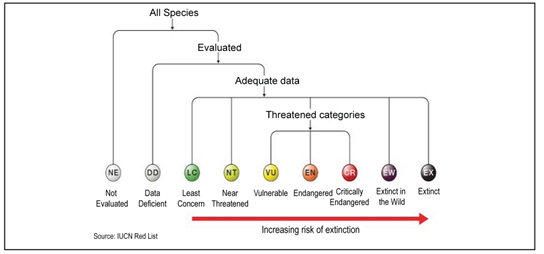Kerala to have its own regional red list of birds
Context
Kerala will soon have its own red list of birds. The Kerala Bird Monitoring Collective led by Kerala Agricultural University and the Bird Count India will conduct the regional red list assessment.
About
- Kerala will be the first State to have a region-specific red list of birds.
- Assessment will be done on the basis of the International Union for Conservation of Nature (IUCN) guidelines.
- The IUCN guidelines for preparing the red list have five main criteria:
- The population size reduction measured over 10 years or three generations is one of the major guidelines.
- Geographic range on the basis of extent of occurrence or area of occupancy is another.
- Small population size and decline;
- Very small or restricted population; and
- Quantitative analysis indicating the probability of extinction in the wild is the other criteria.
Limitations for the global assessment:
- Global assessment is a process prepared in a global context. A species seen common at the global level may be a threatened species at the regional level.
IUCN Red List
Following are the 9 categories in the IUCN red list:
- Extinct (EX) – No known individuals remaining.
- Extinct in the wild (EW) – Known only to survive in captivity, or as a naturalized population outside its historic range.
- Critically endangered (CR) – Extremely high risk of extinction in the wild.
- Reduction in population size (>90% over the last 10 years),
- Population size (number less than 50 mature individuals)
- Quantitative analysis showing the probability of extinction in wild in atleast 50% in their 10 years)
- It is therefore considered to be facing an extremely high risk of extinction in the world.
- Endangered (EN) – High risk of extinction in the wild.
- Reduction in population size (70% over the last 10 years),
- Population size (estimated to number fewer than 250 mature individuals)
- Quantitative analysis showing the probability of extinction in wild in atleast 20% in their 20 years
- It is therefore considered to be facing a very high risk of extinction in the wild.
- Vulnerable (VU) – High risk of endangerment in the wild.
- Reduction in population size (>50% over the last 10 years),
- Population size (estimated to number fewer than 10,000 mature individuals)
- Quantitative analysis showing the probability of extinction in wild in atleast 10% within 100 years)
- It is therefore considered to be facing a high risk of extinction in the world.
- Near threatened (NT) – Likely to become endangered in the near future.
- Least concern (LC) – Lowest risk. It does not qualify for a more at-risk category. Widespread and abundant taxa are included in this category.
- Data deficient (DD) – Not enough data to assess its risk of extinction.
- Not evaluated (NE) – Has not yet been evaluated against the criteria

Kerala and IUCN list:
- According to the global IUCN red list, Kerala has 64 threatened species of birds.
- In that, Red-headed vulture and White-rumped vulture are critically endangered.
- Steppe Eagle, Banasura Chilappan and Nilgirl Chilappan are endangered and
- 11 species are vulnerable





